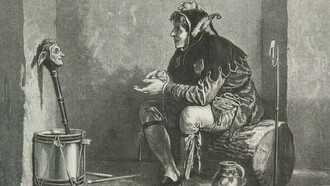From 1845 until 1851, Austen Henry Layard was one of the first archaeologists to excavate in present-day Iraq (at the time under the Ottoman Empire), where he discovered friezes, tablets, monumental sculptures, and other items at the ancient site of Nineveh. These pieces were later shipped back to London and formed the foundation of the British Museum’s Mesopotamian collection.
Layard conducted his excavations through the accepted practice of hiring local labourers in the Ottoman Iraqi province of Mosul. This labour structure, however, which had also been used for excavations by Lady Hester Lucy Stanhope and Giovanni Belzoni, simultaneously empowered locals in the discovery of archaeological heritage while trapping them in a capitalist model that offered minimal pay and no other clear benefits.
Labourers, for instance, were able to control the speed at which excavations progressed – and, indeed, whether they progressed at all. Occasional protests stopped excavations in their tracks as local workmen attempted to subvert or undermine the archaeologists’ work and ensure artifacts and monuments remained in situ (unexcavated). Ottoman officials, as well, tried to stall Layard’s excavations, with the governor (Vali) of Mosul refusing to grant permission to the excavators. He also arranged for grave markers to be moved to the excavations in the middle of the night so further work could be halted on the grounds of desecrating a burial site.
Early arguments from western archaeologists painted Europeans as the rightful heirs of Middle Eastern and Mediterranean artifacts, claiming descendance from the “cradle of civilization” via ancient Greece and Rome. These men and women invoked “Ottoman indifference” (the notion that cultural heritage was neglected under the Ottoman Empire) as justification for the removal and, later, retention, of objects, arguing that European institutions were protecting them from destruction by the Ottoman state. In the light of local protests and the actions of the Vali of Mosul, however, it becomes clear that European assumptions of “Ottoman indifference” were, at best, misguided.
It’s also important to recognize that the first 18 months of Layard’s excavations were conducted illicitly, as he worked covertly without permission from the Sublime Porte in Constantinople.
I would like to recommend some texts for anyone interested in archaeology in late Ottoman Iraq. Layard published a quasi-memoir of his work in Nineveh, describing his exploits at length in Nineveh and its Remains (1849). Surveys of his work have been conducted by Waterfield (1963) and Russell (1997), both of whom also spend a considerable portion of their work examining the reception of Nineveh’s monumental sculpture in London. All three authors provide contextual information for Layard’s presence in the Ottoman Empire, which was facilitated by prominent politicians and archaeologists such as Sir Stratford Canning and Henry Rawlinson.
Russell’s survey of Assyrian reliefs from their discovery in Nineveh to their arrival in Britain uses the diary of Layard’s patron, Lady Charlotte Guest, as a window into Layard’s social life and obligations in London. Her daughter, Lady Enid Evelyn, married Layard in 1869. She also kept a diary, which has been digitized and made available online by the excellent people at Baylor University.
Historians today are increasingly advocating for a historiography that does not just refocus critically on the same major historical figures, but instead shifts focus to those who are often ignored – for instance, local labourers and archaeologists, as well as the social networks that facilitated archaeological work in the Middle East.
On this subject, Tanyeri-Erdemir (2007) suggests that British archaeologists in the 19th century had a more symbiotic relationship with their Ottoman hosts than has been assumed. Using Layard and his protégé, Hormuzd Rassam, as case studies, she argues that foreigners would have had to have a deep understanding of the local language, customs, and politics to facilitate their excavations.
Considering Rassam was a local of Mosul who had been recruited and trained by Layard, this argument is promising (as he would have already possessed the requisite language and networking skills). Further, her recognition of Rassam – widely considered the first Middle Eastern archaeologist – as a key contributor to early archaeology in Iraq is appreciated. As archival repositories are increasingly located and digitized, future research is expected to highlight more on Ottoman and Iraqi archaeologists and the role they played in the collection of Middle Eastern antiquities.
References
Layard, Austen Henry. Nineveh and Its Remains: A Narrative of an Expedition to Assyria During the Years 1845, 1846, & 1847. London: John Murray, 1849.
Mickel, Allison. “Essential Excavation Experts: Alienation and Agency in the History of Archaeological Labor.” Archaeologies: Journal of the World Archaeological Congress 15 (2019): 181-205.
Russell, John Malcolm. From Nineveh to New York: The Strange Story of the Assyrian Reliefs in the Metropolitan Museum & the Hidden Masterpiece at Canford School. New Haven, CT: Yale University Press, 1997.
Tanyeri-Erdemir, T. “Going Native Through Archaeology: The Impact of British Explorers and Archaeologists in the Ottoman Empire in the 19th Century.” Isimu 10 (2007): 65-74.
Waterfield, Gordon. Layard of Nineveh. London: John Murray, 1963.















